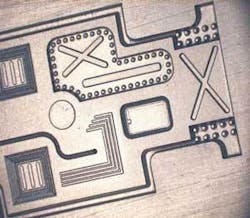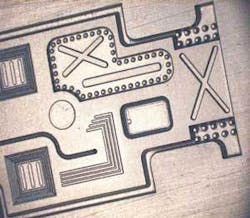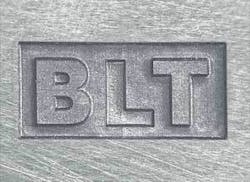Deep engraving: Making the right choice
Choosing a laser deep engraving system requires careful consideration of process methodology, materials, and engraving characteristics
Rick Davis
Deep engraving is the process of machining high-definition features into the surfaces of tool and mold materials. Because of the high hardness requirements on these materials high-speed routing with conventional CNC machines places a high burden on tooling costs. Laser deep engraving is an excellent alternative because of its inherent non-contact approach. With laser deep engraving the light intensities on the workpiece are extremely high. Due to these intensities, the material in the laser zone is melted and/or evaporated. High pressures in the laser zone arise forcing the removal of melted or evaporated material from the workpiece.
Laser deep engraving provides the following advantages over conventional deep engraving processes:
- No wear of mechanical engraving tools
- Engraving on sensitive areas is possible due to the non-contact method
- High engraving speeds on heat-treated materials
- Extremely high resolution is possible with small spot sizes
- Hard-to-reach areas are possible to engrave with lasers
- Programming flexibility
However, a standard laser marker is not the optimal solution when considering a tool for deep engraving applications for tools and molds. There are many factors to consider in order to make the best and most informed decision when investing in a deep engraving solution. These factors may vary from one organization to the next in terms of importance and scale, but in most cases the following factors are relevant.
The use of lasers in deep engraving applications is not a new concept. The process involves a high-peak-power modulated laser at very high repetition rates-typically in the range of 40 to 100 kHz, depending on the surface conditions desired. There are many lasers to choose from on the market but the vast majority that is used in applications for deep engraving on tool and mold materials are 1 micron with regard to wavelength. The choice becomes difficult in that there are a lot of differences from one laser to the next. Characteristics such as pulse length, spot size, and repetition rates play a role in the decision-making process along with many other factors. Companies that take a hard look at all the factors involved are the ones that don’t run into surprises once they own a piece of equipment.
There is a general myth that any marking system on the market can handle deep engraving applications. This myth is primarily driven by over-aggressive sales and marketing efforts and consumers that don’t consider all the necessary factors in making the most informed buying decision. The decision-making process should include the following.
Material considerations-Careful consideration of the materials that are to be processed will greatly influence one’s decision when selecting the laser source for deep engraving.
Material grades such as tool steels and alloys such as aluminum, copper, and brass all make a difference in the average and peak power requirement of the laser used. Aluminum, for instance, will require shorter pulse lengths and higher peak power pulses than do carbon-based tool steels. In addition, the physical characteristics of the final workpiece-size and weight, quantity of parts (cycle time), loading/unloading, workpiece orientation, and workpiece fixturing-will determine the machine configurations.
Engraving considerations-Engraving depth will dictate the set-up of the laser used with regards to mode structure, beam expansion, focal length, and resonator set-up. The system should provide the opportunity for flexibility in these areas. Quality issues such as surface finish will tie in with overall process cycle times. Removal rates can range from as little a 1-5 cm2 to as much a 12 cm2 or higher.
The tolerance of the engraving is dependant on the removal rates for a given engraving parameter. Higher removal rates will generally lead to less accuracy of the engraving. Higher tolerance requirements may require additional sub-systems such as depth measurement devices. The device used can range from a mechanical probe to a laser measuring tool. This also will add cost to the system, but these tools will make the difference between processing good or bad parts.
The engraving classification must be addressed in making the right choice with regard to programming capabilities. The demand on the programming software requirement increases depending on the engraving classification. The software must have strong import/export functionality as well as overall user friendliness. Users that provide a wide range of product to many markets will have higher demands with regards to software, programming, file management, and order tracking. The company and machine you choose must be able to provide a full range of options. Laser engraving software packages can be customizable to meet the needs of a particular customer’s application. These packages should include the following options: 2D or 3D graphics modules; plotting, hatching, and contouring; special functions for texturing surfaces; and post processing for galvanometer programming.
System features-Deep engraving laser systems should be designed around the tasks that the application demands and dictates. Not all systems on the market consider the critical issues that deep engraving places on the system from an application standpoint. In addition to the basic laser considerations discussed already, the deep engraving laser machine tool should provide laser safety (laser classification per CDRH requirements); ergonomics (workpiece weights and sizes); waste removal or fume extraction, including smoke, spatter, dross; environmental factors; and facility considerations such as machine size and plant conditions.
Making the right choice for any machine, and particularly laser deep engraving systems, can require the aide of a simple decision matrix. It is recommended that careful consideration be put into listing the important factors that surround a customer’s demands or application requirements. Listing these in a matrix and assigning a scoring system can provide a great tool for making the most informed decision.
The table provides a sample of a decision matrix that is ranked on a scale of importance from top to bottom. Each category can be given a score from 0 to 10. Careful and unbiased consideration should be given in order make the best possible decision.
Careful choices
Although laser deep engraving has been around for as long as laser marking, the myth that a laser marking system is the answer for deep engraving is simply not true. The system and application requirements are worlds apart and careful and concise consideration must be given to make the right purchasing decision. Process methodology, materials, and engraving characteristics all play a role along with machine features when making this decision.
Choosing the laser is just one step in the process of buying into a viable deep engraving process that enables the user to load/unload, fixture, program, and deep engrave on the materials and size of workpieces that may come through the production facility. At the end of the day, it comes down to productivity and how much product can be shipped.
Rick Davis ([email protected]) is an industry specialist, micro sales, with Rofin-Sinar, (Plymouth, MI; www.rofin.com).


